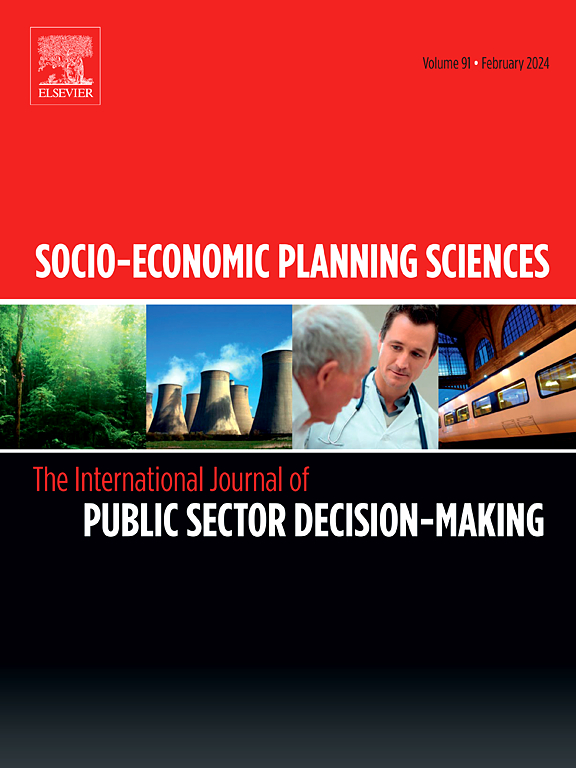Integrated sustainability perspective and spillover effects of social, environment and economic pillars: A case study using SEY model
IF 6.2
2区 经济学
Q1 ECONOMICS
引用次数: 0
Abstract
This study examines the integrated sustainability perspective by mapping the spillover effects among sustainable development pillars including social, environment, and economy. To this end, it estimates the sustainability elasticities between a developing country, Iran, and six global regions including 1- North America, 2- Latin America and Caribbean, 3- European Union, 4- Sub-Saharan Africa, 5- Middle East and North Africa (MENA) and 6- East Asia and Pacific. This estimation uses the SEY model, an econometric package involving simultaneous equations systems, Vector Autoregressive models (VAR), and Granger causality within 1971–2019. This research differs from the previous studies by exploring the sustainability spillovers not only spatially but also across various pillars of sustainable development. The results show that the pillars of sustainable development have significant and positive elasticities. This finding accepts the integrated sustainability perspective since the pillars of sustainable development indicate considerable and synergistic effects from both spatial and contextual outlooks. In this way, the findings support globalization, openness, and flow-based governance, consistent with Sustainable Development Goals (SDGs) 16 (Peace, justice and strong institutions) and 17 (Partnerships for the goals). Therefore, policymakers should strengthen the globalization and openness by establishing and promoting international agreements, global organizations, and inclusive frameworks not only in trade, finance, and economy but also in cultural, social, and political affairs.
综合可持续性视角以及社会、环境和经济支柱的溢出效应:利用 SEY 模型进行案例研究
本研究通过分析可持续发展支柱(包括社会、环境和经济)之间的溢出效应,对综合可持续性视角进行了研究。为此,本研究估算了发展中国家伊朗与全球六个地区之间的可持续性弹性,包括 1- 北美、2- 拉丁美洲和加勒比地区、3- 欧洲联盟、4- 撒哈拉以南非洲、5- 中东和北非(MENA)以及 6- 东亚和太平洋地区。该估算使用了 SEY 模型,这是一个计量经济学软件包,涉及 1971-2019 年期间的同时方程系统、向量自回归模型(VAR)和格兰杰因果关系。与以往研究不同的是,本研究不仅从空间角度,而且从可持续发展的各个支柱角度探讨了可持续发展的溢出效应。结果表明,可持续发展的各个支柱都具有显著的正弹性。这一结果接受了综合可持续性的观点,因为从空间和环境的角度来看,可持续发展的各个支柱都具有相当大的协同效应。因此,研究结果支持全球化、开放和基于流动的治理,这与可持续发展目标(SDGs)16(和平、公正和强有力的机构)和 17(目标伙伴关系)是一致的。因此,政策制定者应加强全球化和开放性,不仅在贸易、金融和经济领域,而且在文化、社会和政治事务领域建立和促进国际协定、全球组织和包容性框架。
本文章由计算机程序翻译,如有差异,请以英文原文为准。
求助全文
约1分钟内获得全文
求助全文
来源期刊

Socio-economic Planning Sciences
OPERATIONS RESEARCH & MANAGEMENT SCIENCE-
CiteScore
9.40
自引率
13.10%
发文量
294
审稿时长
58 days
期刊介绍:
Studies directed toward the more effective utilization of existing resources, e.g. mathematical programming models of health care delivery systems with relevance to more effective program design; systems analysis of fire outbreaks and its relevance to the location of fire stations; statistical analysis of the efficiency of a developing country economy or industry.
Studies relating to the interaction of various segments of society and technology, e.g. the effects of government health policies on the utilization and design of hospital facilities; the relationship between housing density and the demands on public transportation or other service facilities: patterns and implications of urban development and air or water pollution.
Studies devoted to the anticipations of and response to future needs for social, health and other human services, e.g. the relationship between industrial growth and the development of educational resources in affected areas; investigation of future demands for material and child health resources in a developing country; design of effective recycling in an urban setting.
 求助内容:
求助内容: 应助结果提醒方式:
应助结果提醒方式:


